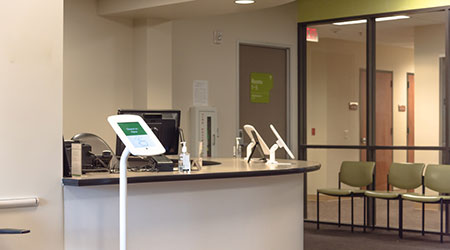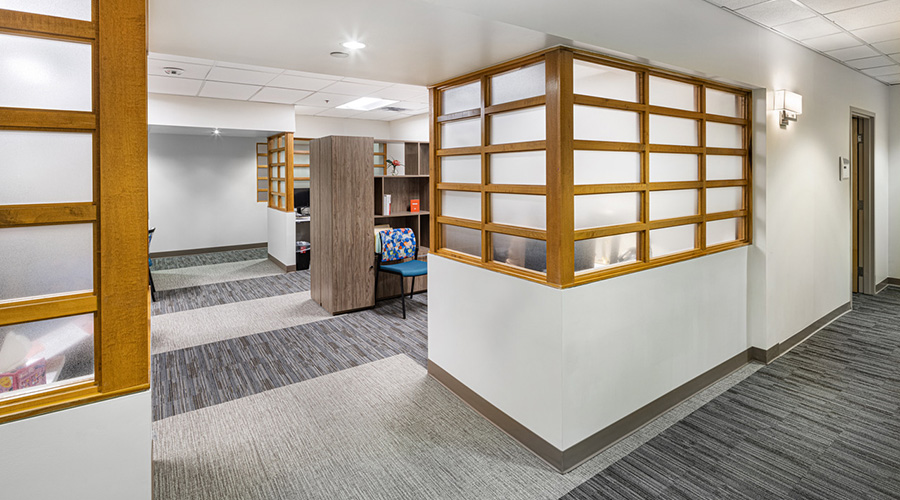Facility preparation and clear communication are critical in a health emergency. This is particularly true at a healthcare facility. Following are five essential best practices that healthcare institutions are following to help reduce the impact from an outbreak of an infectious disease:
1. Use visitor management to provide a single source of real-time and historical insights into who is currently and was recently in the facility.
The visitor experience begins at the front desk or lobby, so it needs to make a great first impression. However, in an emergency event, strict control of who’s entering the lobby needs to be maintained and clearly communicated to visitors. Doing so minimizes risk to patients, visitors and the hospital medical and administrative staff. A good visitor management system allows:
- High-quality and compliant visitor experiences that reduce wait times by enabling check-in at a self-service kiosk
- Visitor experiences that can be customized to specific security needs, like keeping check-in short and simple or requiring additional security pre-checks
- Automated compliance as it relates to visitor access rules with historical visit reports
2. Add pre-check questions to your visitor registration kiosk
A flexible, enterprise-grade visitor management system enables healthcare facilities to extend security at the registration desk or kiosk with additional steps the visitor must take during sign-in. Some facilities are using this strategy to combat the current global novel coronavirus outbreak. It has already proven successful in the past. As an example, a children's hospital in the U.S., which used it to reduce facility infection rates by 25 percent over a two-year period. The hospital used a commercial, off-the-shelf physical identity and access management (PIAM) solution from HID Global to achieve two key capabilities that are particularly important:
- Enhance its visitor registration policy with additional mandatory questions to help identify any visitors who may need other screenings.
- Add a mandatory pop-up at the visitor registration kiosk to ask further questions during the check-in process. In the case of a major outbreak, this can include “Have you visited or transited through any of these countries in the past 30 days?” Checkboxes can then be provided for any countries that are currently experiencing viral outbreaks.
3. Understand who has visited your facility, and when
Today’s enterprise-grade visitor management systems enable healthcare facilities to automatically maintain an auditable trail of activity. This allows them to easily retrieve historical visit reports that provide a timeline of who was in their facility, and when. They also provide a single dashboard that consolidates useful visitor insights, and historical reports with comprehensive visitor details including location and contact information. This reporting enables healthcare organizations to comply with General Data Protection Regulation (GDPR) and other privacy regulations.
4. Enhance your front desk/lobby with clear communication on how to reduce infection risks for patients, visitors, medical professionals and hospital staff
Healthcare facilities worldwide are following best practices outlined by the World Health Organization (WHO), including:
- Re-enforce and convey these best practices by displaying guideline posters in the front lobby and throughout the facility.
- Add posters that encourage everyone to thoroughly and regularly wash their hands.
- Encourage everyone to cough or sneeze into their shirt sleeve in their flexed elbow or cover their mouth and nose with a tissue.
- Encourage everyone to keep a relatively safe distance from each other and use alternatives to handshakes when saying hello.
5. Use real-time location services to track movement and trace contact in the healthcare facility
When healthcare professionals are dealing with extreme volumes of patients and need a collaborative approach to disease tracking to prevent further spread, using real-time location services helps healthcare facilities implement virtual barriers and create “healthy zones” — from triage to admission.
More importantly, real-time locations services enable users to trace potentially infected patients and their interaction patterns to quickly determine who may have been in contact with a virus. When healthcare facilities use real-time location services to digitally track people, locations and interactions they can instantly contain and clean infected areas and suppress further spread.
This data-driven contact tracing is critical for tracking the spread of disease. The risk of spread is heightened when a patient’s status and severity of health goes undetected. Within the time span of entering a facility and undergoing testing, many patients and staff may have been exposed. To combat this, WHO recommends that healthcare organizations precisely capture the location and interactions of health care practitioners and patients. With extreme volumes of patients, contact tracing becomes more difficult – causing logistical challenges for clinicians to effectively administer care.
Following are a few steps that hospitals and clinics can take to help better track people, places and assets that may have been exposed:
- Use a real-time location solution that can be up and running within hours.
- Monitor patients and staff using Bluetooth Low Energy (BLE) enabled credentials pre-provisioned to each staff member and patient.
- Create “Safe Zones” using geofences and send instant alerts when people move outside of designated areas.
- Access real-time analytics that includes location within defined zones, allowing users to see contact type and contact duration within seconds for each patient visit.
- Leverage standalone connectivity using BLE over cellular network and mobile devices minimizes disruption of service.
Solutions for delivering these capabilities allow global healthcare organizations to digitally account for patient movements and encounters so they can efficiently monitor interactions. When hospitals are tasked with separating the healthy patients and staff from the contagious, these solutions precisely capture location and interactions of healthcare practitioners and patients.
Healthcare facilities must grapple with a variety of challenges when it comes to infectious diseases. These challenges can be solved with a combination of comprehensive and automated visitor management policies along with the ability to track and trace movements and interactions throughout the facility.
Ian Lowe is a Product Marketing Director of HID SAFE in IAM Solutions, HID Global.

 Code Compliance Isn't Enough for Healthcare Resilience
Code Compliance Isn't Enough for Healthcare Resilience Ribbon Cutting Marks First Phase Completion for New Montefiore Einstein Facility
Ribbon Cutting Marks First Phase Completion for New Montefiore Einstein Facility Brooks Rehabilitation Launches 3 New Major Construction Projects
Brooks Rehabilitation Launches 3 New Major Construction Projects Joint Commission Standards: What Updates Matter Most?
Joint Commission Standards: What Updates Matter Most? Swinerton Completes Construction at Atlanta's Grady Hospital
Swinerton Completes Construction at Atlanta's Grady Hospital